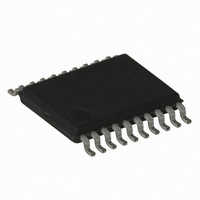AT89LP4052-20XU Atmel, AT89LP4052-20XU Datasheet - Page 7

AT89LP4052-20XU
Manufacturer Part Number
AT89LP4052-20XU
Description
IC 8051 MCU FLASH 4K 20TSSOP
Manufacturer
Atmel
Series
89LPr
Datasheet
1.AT89LP2052-20PU.pdf
(94 pages)
Specifications of AT89LP4052-20XU
Core Processor
8051
Core Size
8-Bit
Speed
20MHz
Connectivity
SPI, UART/USART
Peripherals
Brown-out Detect/Reset, POR, PWM, WDT
Number Of I /o
15
Program Memory Size
4KB (4K x 8)
Program Memory Type
FLASH
Ram Size
256 x 8
Voltage - Supply (vcc/vdd)
2.4 V ~ 5.5 V
Oscillator Type
Internal
Operating Temperature
-40°C ~ 85°C
Package / Case
20-TSSOP
Processor Series
AT89x
Core
8051
Data Bus Width
8 bit
Data Ram Size
256 B
Interface Type
UART, SPI
Maximum Clock Frequency
20 MHz
Number Of Programmable I/os
15
Number Of Timers
2
Operating Supply Voltage
2.4 V to 5.5 V
Maximum Operating Temperature
+ 85 C
Mounting Style
SMD/SMT
3rd Party Development Tools
PK51, CA51, A51, ULINK2
Development Tools By Supplier
AT89ISP
Minimum Operating Temperature
- 40 C
Package
20TSSOP
Device Core
8051
Family Name
AT89
Maximum Speed
20 MHz
Lead Free Status / RoHS Status
Lead free / RoHS Compliant
Eeprom Size
-
Data Converters
-
Lead Free Status / Rohs Status
Details
7. Comparison to Standard 8051
7.1
7.2
7.3
7.4
7.5
7.6
3547J–MICRO–10/09
System Clock
Instruction Execution with Single-cycle Fetch
Interrupt Handling
Timer/Counters
Serial Port
Watchdog Timer
The AT89LP2052/LP4052 is part of a family of devices with enhanced features that are fully
binary compatible with the MCS-51 instruction set. In addition, most SFR addresses, bit assign-
ments, and pin alternate functions are identical to Atmel's existing standard 8051 products.
However, due to the high performance nature of the device, some system behaviors are differ-
ent from those of Atmel's standard 8051 products such as AT89S52 or AT89S2051. The
differences from the standard 8051 are outlined in the following paragraphs.
The CPU clock frequency equals the external XTAL1 frequency. The oscillator is no longer
divided by 2 to provide the internal clock, and x2 mode is not supported.
The CPU fetches one code byte from memory every clock cycle instead of every six clock
cycles. This greatly increases the throughput of the CPU. As a consequence, the CPU no longer
executes instructions in 12 to 48 clock cycles. Each instruction executes in only 1 to 4 clock
cycles. See
The interrupt controller polls the interrupt flags during the last clock cycle of any instruction. In
order for an interrupt to be serviced at the end of an instruction, its flag needs to have been
latched as active during the next to last clock cycle of the instruction, or in the last clock cycle of
the previous instruction if the current instruction executes in only a single clock cycle.
The Timer/Counters increment at a rate of once per clock cycle. This compares to once every
12 clocks in the standard 8051.
The baud rate of the UART in Mode 0 is 1/2 the clock frequency, compared to 1/12 the clock fre-
quency in the standard 8051. In should also be noted that when using Timer 1 to generate the
baud rate in Mode 1 or Mode 3, the timer counts at the clock frequency and not at 1/12 the clock
frequency. To maintain the same baud rate in the AT89LP2052/LP4052 while running at the
same frequency as a standard 8051, the time-out period must be 12 times longer. Mode 1 of
Timer 1 supports 16-bit auto-reload to facilitate longer time-out periods for generating low baud
rates.
The Watchdog Timer in AT89LP2052/LP4052 counts at a rate of once per clock cycle. This
compares to once every 12 clocks in the standard 8051.
Section 22. “Instruction Set Summary” on page 52
AT89LP2052/LP4052
for more details.
7












